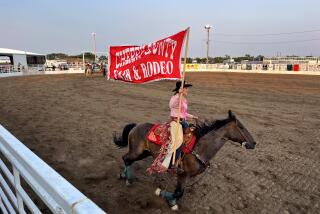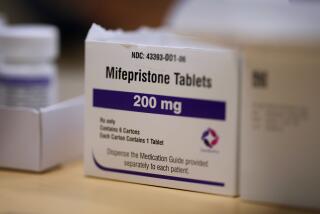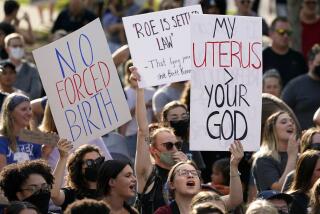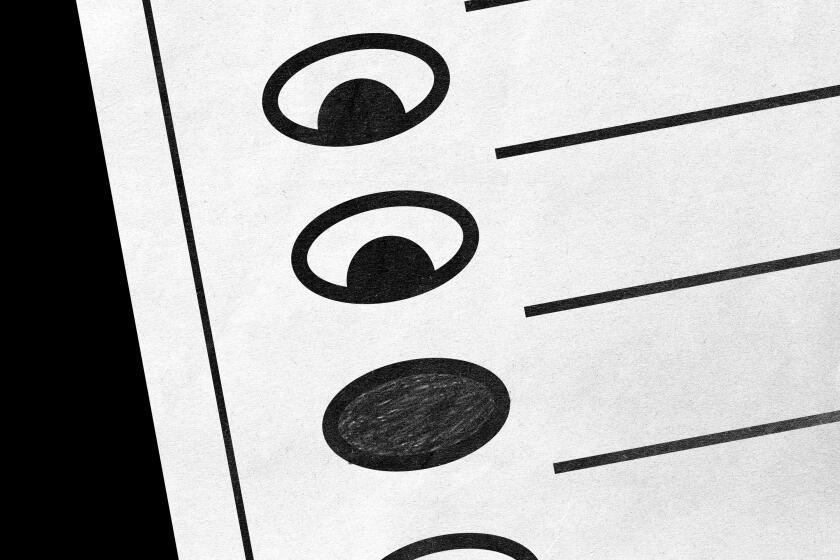Looking for Rockwell Scenes in Iowa Landscape
DES MOINES, Iowa — In search of the real Iowa. . . .
There on the TV screen was an incredible spectacle in advance of Monday’s ballyhooed caucuses. Republican presidential candidate Pierre (Pete) du Pont was in a diner somewhere in Smalltown, Iowa, lecturing rural folk about farm policy.
Picture it: Rich, aristocratic, Ivy League, sniffy-looking, exquisitely tailored Du Pont of Delaware, a descendant of a famous industrial family, wearing a coat that looked more expensive than half of the cars Iowa’s farmers drive, getting down and dusty and howdy-neighborly, talking pigs and crops and subsidies. Pete du Pont, man of the soil.
The camera panned the faces of the diner patrons as they listened to Du Pont. Some looked mildly interested. Others looked as if they wanted him to leave. But he didn’t leave. It was ugly.
Not every campaign appearance is made with media in mind. But diners do make great TV for out-of-state viewers who may be voting for some of these candidates further down the line, evoking as they do the convenient Iowa stereotype of Ma and Pa Kettle.
Another town, another diner.
Late last month it was Hoppy’s Diner in Boone, where ABC, CBS and C-SPAN were set up for Democrat Gary Hart’s appearance in an eatery that normally seats 104. “But people were jammed in here, even standing outside and looking in the window,” said Hoppy’s owner Ken Hopkins.
“There’s another place in town with more meeting rooms, but the Hart people saw us looking a little more like Iowa and the Midwest,” Hopkins said. “We’re nice and homey, and we have a soda fountain sort of like the 1940s. I think that was kinda what they were lookin’ for.”
Then Hoppy’s was Hart’s TV prop?
“You might be able to look at it that way,” Hopkins said. “But then again, we are on Main Street.”
Before Hart showed up, however, another Democratic candidate made use of his crowd, Hopkins said. “Hart was late. It so happened Bruce Babbitt was in town appearing at a bank, but he wasn’t drawing much of a crowd. When some of his people saw the crowd gathered for Hart, they brought him over to talk to them while they waited for Hart.”
Hopkins said that Babbitt promised to make a return campaign visit to Hoppy’s before Monday, which makes him happy. What’s good for the candidates is good for business.
Pitchforks, Rockwellian scenes and tiny hamlets are just the ticket for many of the news media--including TV crews from individual stations--who have poured into Iowa to cover the caucuses.
One of their quests is to find “real Iowans” to interview and photograph, according to Kathleen Wood, who heads Iowa Caucus Project 88, a volunteer-staffed center set up here in July to help the press.
Of course, real Iowans also live in Des Moines, Davenport, Cedar Rapids, Waterloo and Dubuque. “But reporters tell us that they want to see a typical caucus-goer and that he must be a farmer,” Wood said. “The only problem is that your farmer is not your typical caucus-goer.”
Still, many of the media refuse to be dislodged from their preconceived perceptions of Iowans.
“TV crews generally are looking for a country scene,” Wood said. “One came in here wanting to find a caucus site that’s a small church or a one-room schoolhouse. But most of the caucuses take place in much larger buildings. And I’m not even sure there are any one-room schoolhouses left in Iowa.”
With so much emphasis on the caucuses as a nomination-shaping spectacular, media have been crisscrossing Iowa almost as long as some of the candidates. Last November, one reporter asked Wood to direct him to a marketplace in Des Moines where farmers brought their crops at 7 a.m.
She told him that it was the wrong time of the year for that, but that he was in luck because many farmers were in town attending a big meeting on farm technology. “But he didn’t want that,” Wood said.
Then there was the radio reporter from California who complained to Wood that he was never served cream with his coffee in Iowa restaurants unless he asked for it. And even then the cream was not the real thing.
He told her he found that strange “since Iowa is a dairy state.” When she informed him that Iowa was not a dairy state, he seemed perplexed. “But . . . then why do they have all those cows in the fields?” he asked. “Those are not dairy cows,” she told him. “They’re beef cattle.”
Real Iowans meet the real media.
More to Read
Get the L.A. Times Politics newsletter
Deeply reported insights into legislation, politics and policy from Sacramento, Washington and beyond. In your inbox three times per week.
You may occasionally receive promotional content from the Los Angeles Times.










